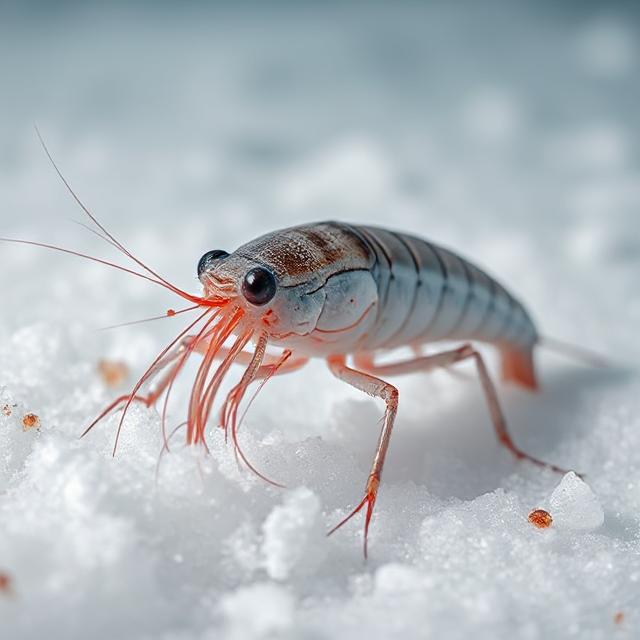Here’s a full and detailed overview of the Antarctic Krill (Euphausia superba)—a tiny creature with a huge impact on the Southern Ocean ecosystem:
❄️ Antarctic Krill: General Overview
Antarctic krill are small, shrimp-like crustaceans that form one of the largest biomasses on Earth. They are a keystone species in the Southern Ocean, serving as a crucial food source for whales, seals, penguins, fish, and seabirds. Despite their size, they drive one of the most important marine food webs on the planet.

🔬 Classification
- Kingdom: Animalia
- Phylum: Arthropoda
- Subphylum: Crustacea
- Class: Malacostraca
- Order: Euphausiacea
- Family: Euphausiidae
- Genus: Euphausia
- Species: Euphausia superba
🦐 Physical Characteristics
- Size: Up to 6 cm (2.4 inches) long
- Weight: ~2 grams
- Appearance: Transparent to pinkish body, large black eyes, 10 legs, and numerous feathery appendages for swimming and filter feeding
- Bioluminescence: Possess light-producing organs (photophores) on their body used for camouflage and communication
🌍 Habitat
- Range: Circumpolar, Southern Ocean surrounding Antarctica
- Depth Range: Surface to 200 meters (some migrate to deeper waters)
- Temperature: Cold, ice-covered waters between –2°C and +2°C
- Habitat Role: Found under sea ice in winter and in open water during summer; form dense swarms that can be seen from space
🌿 Diet
- Type: Filter-feeding herbivore (mostly)
- Primary Food: Phytoplankton (microscopic algae), especially diatoms
- Secondary Food: Zooplankton, detritus
- Feeding Mechanism: Use thoracic limbs to create a feeding basket and filter food from the water
- Winter Diet: Scrape algae from the underside of sea ice
🧠 Behavior
- Swarming: Form massive swarms—up to 30,000 individuals per cubic meter
- Vertical Migration: Migrate daily—up to the surface at night to feed, descend during the day to avoid predators
- Defense: Swarming behavior and bioluminescence may confuse predators
- Mobility: Strong swimmers despite their size; can escape predators with flicks of the tail
🍼 Reproduction
- Breeding Season: Primarily summer (December–March)
- Spawning: Females release thousands of eggs into open water
- Development: Eggs sink to 2,000–3,000 meters before hatching, then larvae rise through the water column as they mature
- Lifespan: 5–7 years (long for a small marine animal)
🛡️ Conservation Status
- IUCN Status: Least Concern, but vulnerable to climate change and overfishing
- Main Threats:
- Climate change: Melting sea ice reduces food availability
- Commercial fishing: Krill harvested for aquaculture feed, supplements, and oil
- Management: CCAMLR (Commission for the Conservation of Antarctic Marine Living Resources) sets catch limits and monitors krill fishing
🎉 Fun Facts
- Biomass Giant: Antarctic krill may represent over 300 million tons of biomass—more than any other animal species.
- Whale Food: A single blue whale can eat up to 4 tons of krill per day.
- Glow in the Dark: Their bioluminescence helps them avoid predators by blending in with the faint light from above (counterillumination).
- Ecosystem Engineers: Krill feces and molted shells help sequester carbon by sinking it to the ocean floor (part of the biological carbon pump).
- Ice Dependency: Krill larvae depend on sea ice algae in winter—making them especially sensitive to warming climates.